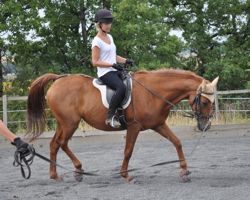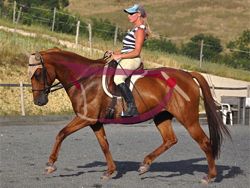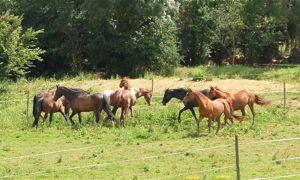

|
Welcome to the whole horse newsletter. We believe that every part of a horse's life is important. Both for his own well-being and for the success of your training program. This newsletter brings together the management and training aspects of a particular topic, giving you a holistic perspective on the horsemanship issues we encounter every day. This month's subject is: What Does Engagement Feel Like?Spotlight On Riding: What Does Engagement Feel Like? The Relevance of Engagement to All Riders First we have to be clear on what engagement, often described as the horse being 'on the bit', actually is. Although there are different degrees of engagement, and it can come and go when we are riding, in itself it is in fact a particular gymnastic state, when the horse brings into action a specific set of postural muscles which fundamentally alter the dynamic of how he carries himself. It is only in this state that the horse is able to carry the rider in balance and without the various damaging effects that, otherwise, a rider inevitably has on the horse.
 This is why any educated rider who cares about their horse's well-being will make engagement a priority when they ride, even if it is in its most basic form. Apart from the fact that an unbalanced horse is never a pleasure to ride, nor is he safe.
This is why any educated rider who cares about their horse's well-being will make engagement a priority when they ride, even if it is in its most basic form. Apart from the fact that an unbalanced horse is never a pleasure to ride, nor is he safe. For a more in-depth description of engagement see What Does 'On The Bit' Really Mean?
Before we can know how to identify the feeling of engagement, the rider has to become aware of what the lack of balance which is inherent to the horse's movement when he is not engaged feels like. The problem is that, as riders, most of us have ridden horses who were not engaged for many years. This means that we get so used to the feeling of the horse being out of balance and not engaged that we don't even recognize that a whole other realm of riding exists. We also get used to remedying the situation with the wrong position and a reliance on the reins in order to balance ourselves on top of the horse's unbalanced motion, instead of using our own body to bring the horse into balance. The next time you ride, try to heighten your awareness of your physical feelings of balance or imbalance, and especially notice any time you feel compelled to bring your hands towards your body to control the horse. As humans we are 'programmed' to use our hands to balance ourselves, so any involuntary movement with your hands when you are riding (from side-to-side as well as back and forth) is an indication to you that your horse is out of balance and therefore not engaged. The next step is to begin to feel this lack of balance in your body, that is, how the horse is pushing your weight, your seat, leg and whole position around. The more we get used to being on a horse, the more we get good at absorbing the horses crookedness, hollowness, and various imbalances. We need to undo this natural adaptation through a conscious awareness of our body, so that we can then do something about it.
The 'law of attraction' dictates that in order to manifest a certain state in physical reality, you need to first assume that state in your own being. This is precisely the case for riding, and actually pinpoints one of the greatest hurdles for a rider in putting a horse correctly on the bit. It is the difference between being formed by the horse, and forming the horse yourself. This is why it is crucial to recognize the feeling of when the horse is working in engagement, then you can reproduce it in your body in order to turn things around when they are not going well. Of course, you need to know what to do with your position and aiding in order to achieve engagement, but simply becoming aware of how your own body feels when you ride is a crucial way of orientating yourself towards good riding.

As a rider you feel:
Most Importantly, the feeling of engagement is the connection between what is going on in the horse's hind-end with the softening that you feel in the rein contact - as if they become unified - as Charles De Kunffy describes so well: "you should feel the horse's hocks in his mouth!" Above all, engagement is an incredibly good feeling, for both horse and rider, because we instinctively enjoy the feeling of balance and power. Instead of always focusing on what you are doing when you ride, start to become aware of the moments when it simply feels good. This is the most reliable way of finding the direction towards correct engagement.
Spotlight on Management: Relaxation and Trust Come First A horse's ability to engage correctly is not just down to what you do when you ride, in fact it is greatly influenced by his whole lifestyle and relationship with people. On a physical level, the horse cannot actually engage his ring of postural muscles if he is holding too much tension in his body, particularly in the diaphragm. Many horse's have a high level of this physical tension without their owners even being aware of it, and often it is caused by an unnatural lifestyle. This may be due to too much confinement in the stable, lack of contact with other horses, and the absence of the security of the herd environment - a fundamental necessity for all horses. Tension may also come from an unhealthy diet based on high levels of carbohydrate and a lack of continuous access to forage. Physical discomfort from unhealthy feet, and musculo-skeletal problems is often an additional source of tension in the horse.
This trust is established not only by giving the horse a healthy and happy lifestyle, but also by continuously showing him that you are a reliable leader in every interaction you have with him: leading, grooming, tacking him up, and so on - in other words, it is not just what you do with your horse, but how you do it. If you have already established the position of a trustworthy leader by being calm, reliable, and self-assured, before you get on your horse to ride, then the physical barriers that stand in the way of engagement will already be weaker.
New pages on Happy Horse Training: The Origins of Dressage Training Understanding Horse Herd Dynamics Dressage Double Bridle Misconceptions The Importance of the Posture in Riding Natural Horse Training The Monty Roberts Technique: How It Works For Us Monty Roberts Join Up In Action Click here to return to Happy Horse Training home New! CommentsAnything to say about this page? Leave your comment in the box below. |
Join the Whole Horse Newsletter
HHT's free monthly newsletter giving you wide-ranging and intelligent insights into holistic horsemanship.
Just enter your details below to join.
Free bonus on the riding position with all new subscriptions: Ten Top Tips To Instantly Improve Your Connection With Your Horse.
Train Your Horse
The Holistic Way
How To Train A Horse Without Force is a unique guide to training horses through energetic connection and gymnastic training. Part 1 covers everything on the ground, from handling to the lungeing technique that develops strength, straightness and engagement. Comes with a free eBook supplement on Horse Trauma.
Click here for more details.
Do You Have
A Horse Story
To Share On HHT?
So many people have been through wonderful experiences with horses, whether in training or otherwise. If you've made a change in a horse's life - or one has made a change in yours - tell us about it here.
Learn How To Trim
Your Own Horse's Feet
The Simple Seven-Step Natural Trim is a comprehensive step-by-step guide to a cutting-edge barefoot trim. Click here to find out more.



